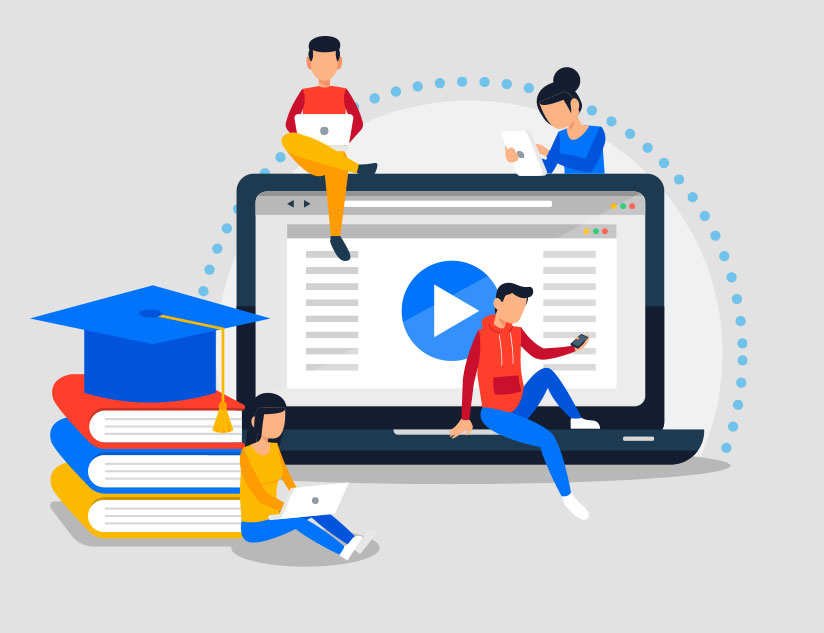Ever imagine what would happen if your phone’s language-learning app didn’t let you skip over to your favorite module? If you’ve got the notorious attention span problem, chances are that you’d skip the whole thing altogether. That’s what could happen if the little birdie tried to have its way — except that it doesn’t.
That’s the power of microlearning for you. This app in your phone teaches you languages with the help of bite-sized lessons, adjusts to your voice and accent, and sets manageable daily goals. It illustrates, reiterates, urges you to test yourself — helping you with greater retention of the language you’re learning. The BBC too went the microlearning way to combat Britain’s Coronavirus-induced homeschooling crisis, with its six-20-minutes-a-day initiative, called Bitesize Daily.
Compared to traditional eLearning programs and MOOCs, microlearning has seen better completion rates and overall greater achievement in terms of learning outcomes. Since these courses are defined by compactness, they also prove to be facilitators of approaches such as peer learning, just-in-time learning and spaced repetition.
This video explains it well:
The emergence of mobile learning and virtual classroom technology has enabled the delivery of bite-sized units of instruction. Platforms such as MagicBox™, which offer offline learning and targeted course authoring, help create personalized learning experiences that don’t overwhelm or exhaust the learner, which can otherwise be the reality for modern K-12 and higher education students.
How Microlearning Helps K-12 Education
The University of Edinburgh defines student engagement as “both a route to success and an outcome of excellent teaching.” Retention, on the other hand, has been a perennial problem for educators.
Microlearning boosts engagement with tools such as mobile-based learning, video classrooms, simulations and gamification. Once it gets the mind tuned to consuming information through these innovative techniques, the learner automatically starts retaining more information.

The duration of the human attention span may continue to be a bone of contention, but the fact remains that to hold it long enough is a tough job. The average duration of a microlearning module is 5-15 minutes, which makes investing attention in it much more worthwhile for the mind.
Breaking up and organizing the learning material into smaller modules is easy for instructors and course creators as well. With publishing platforms, the old, drab PDF-based eBooks are quickly made much more interactive and immersive, thanks to easy integration of multimedia elements.
At the stage of curating the course content then, it all comes down to identifying the must-include elements and the dispensable stuff, in order to avoid cognitive overload. Select a few identified topics that the learners must absolutely know in order to progress, the common mistakes made by learners, and the topics that must be broken up into smaller chunks.
Social media too is being leveraged extensively by educators as delivery tools of microlearning for school students these days. Facebook, Instagram, Snapchat and Twitter offer media overlays, such as video clips, polls, images, and the like, for educators to send out interactive snippets of course content. If you aren’t sure about learners’ privacy and protection on social media, you could partner with a learning management system that complies with federal regulations, like FERPA and COPPA.
Empowering Learners through the Scaffolding Technique
Ever notice how we often learn the recipe of a dish or to fix our washing machine using online video tutorials? The second or the third time, we often don’t need the video at all, since our mind has retained the steps.
So, another way microlearning promotes student engagement is by way of a technique known as instructional scaffolding. Propounded by the Soviet psychologist Lev Vygotsky, the scaffolding theory, true to its name, works by providing instructional scaffolds, or a support framework to help students navigate learning better.
In the context of microlearning, scaffolding works through progressive delivery of course content, with a gradual increase in the level of difficulty. The knowledge retained in the ongoing lesson will be applied in the following lesson, which will also have more in-depth course content.
With the help of online learning platforms, scaffolding can be provided with features such as in-text annotations and interactive assessments, which help reinforce the concepts students have learnt. The four-pronged approach to implementing scaffolding through microlearning is:
1. Break down assessments into smaller subtasks
2. Make assignments/assessments align with the other parts of the course
3. Provide enough examples and analogies
4. Encourage students to evaluate their learning themselves
Instant Feedback Helps Retain Information for Longer
Learners are much more invested in engaging with a course that they can get instant feedback on. It is a desirable practice that helps them have a clear idea of exactly where they stand in pursuit of their academic goal. Instant feedback also works on the principle of operant conditioning, where constant reinforcement is said to promote strengthening of concepts. The mistakes they make in the learning process aren’t cemented in their memory.
Within an institutional online learning setup, this can be arranged by bringing onboard a platform that can provide seamless chat support. For instance, MagicBox™, with its ZenDesk integration, not only allows educators to provide immediate feedback on assignments but also lets students reach out to educators with their queries.
Social media, video games and constantly proliferating handheld devices are a reality, and so are easily distracted young learners. The smart way is to get around these hurdles, which is exactly what the marvel of microlearning does. The technique also leverages their familiarity and tech-savviness to incorporate technology into their learning.
Supporting the idea of education anytime, anywhere, MagicBox™ offers educators and publishers a robust system for designing and creating microlearning content.
Are you looking for a customized digital learning solution, get in touch with us.













